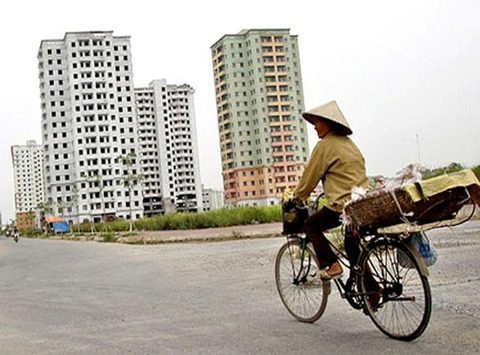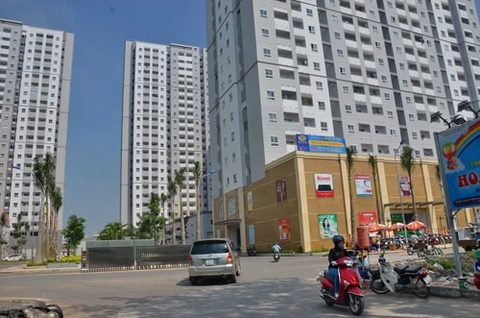Gov’t urges developers to balance supply, demand
Gov’t urges developers to balance supply, demand
Deputy Prime Minister Trinh Dinh Dung asked the construction industry to tighten property development management to prevent an imbalance in supply and demand that could trigger a market bubble.

Dung said at a the Ministry of Construction year-end review conference on Friday that construction investments should hone in on urban planning, especially in major cities like Ha Noi and HCM City.
“This is critical to ensure that urban development stays on the right track and eases pressure on our technical and social infrastructure systems,” Dung said.
Dung said that solving pressing traffic congestion in major cities requires not only investments in traffic infrastructure and organizing alone, but also the development of satellite urban areas and public transport means.
“A master urban planning is needed,” he added.
Dung also urged diligent attention to construction quality and safety standards, asking the Ministry of Construction to join hands with relevant ministries and organisations to tighten their management.
In 2017, the ministry will inspect a number of large-scale high-end property projects, Deputy Minister of Construction Do Duc Duy said.
Duy added that the effort to restructure the property market will continue in line with the National Housing Development Strategy and aim to prevent supply and demand imbalance or undiverse products. “We will focus on developing housing for rent, building social housing and hastening the renewal of degraded apartment buildings.”
The ministry will also develop an information system on housing and the real estate market to improve transparency.
2016 property market highlights
Two years after the amended laws on housing and real estate business came into force--together with policies which better managed the credit flows--the property market continued to gain solid growth in 2016. Despite signs of unbalanced developments in housing supply and demand, the realty market is poised for firm developments in 2017. Here are the 2016 market highlights.
Boom in resort property
2016 was a booming year for resort properties, with the launch of a number of mega projects across the country worth trillions of Vietnamese dong, such as in Quang Ninh, Da Nang, Nha Trang, Phu Quoc, Vung Tau and Vinh Phuc. These have seen the participation of big names including Vingroup, Sun Group, BIM Group, CEO Group and FLC Group. Popular resort products are villas and condotels.
Forecasts remain optimistic for the resort property market. According to property services firm Savills Viet Nam, the number of wealthy households in Viet Nam is expected to double to 530,000 by 2020, boosting demand for resort property products.
Expansion of giants in affordable home
Three years ago, affordable homes dominated the market. But when the property market got back on the recovery track, developers shifted their focus to medium- and high-end segments. Still, 70 per cent of the market demand remains in the affordable segment.
Supply of affordable homes accounted for just 25 per cent of the total apartments opened for sale as of the end of 2016’s third quarter.
However, in a surprising move, property giant Vingroup, well known for luxury brands, announced to develop 200,000 – 300,000 affordable apartments under the brand Vincity, in the next five years, priced from just VND700 million (US$31,250) per unit.
Other developers such as Ecopark, Him Lam and FLC also participated in the field.
Experts forecast that competition in the segment will grow fierce and this would benefit home seekers.
Circular 06/2016/NHNN tightens credit into property market with road map
Late in May, the State Bank of Viet Nam issued Circular 36/2014/TT-NHNN, regulating prudential ratios for the operations of credit institutions and foreign bank branches. This raised the risk index of receivable lending for real estate and securities from 150 per cent (the lowest level) to 200 per cent.
The new Circular 06/2016/TT-NHNN specified a roadmap for the maximum ratio of short-term funds used for medium and long term loans to be reduced from 60 per cent to 40 per cent by the beginning of 2018.
Accordingly, credits into the property market would not be tightened too fast, which would better control the credit flow as well as preventing market bubble from occurring.
VND30 trillion stimulus package ceased
After three years of implementation and a six-month extension, the VND30 trillion (US$1.4 billion) housing stimulus package of loans at preferential interest rates officially ceased at the end of 2016.
State Bank of Viet Nam statistics showed that as of November 30, VND29.24 trillion from the package had been disbursed.
The package helped more than 50,000 homeowners have a home.
Projects mortgaged at banks announced for the first time
After Harmona apartment residents were shocked to learn that their homes could be seized by the bank because the developer had mortgaged the building and failed to repay the loan, HCM and Ha Noi departments of Natural Resources and Environments, for the first time, announced the list of projects which were used as mortgage assets at banks.
The announcement, however, met the opposition of developers who said that this would negatively affect their sales, and that the reason for mortgages should also be made public well to prevent misunderstanding.























